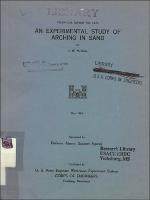Please use this identifier to cite or link to this item:
https://hdl.handle.net/11681/21165| Title: | An experimental study of arching in sand |
| Authors: | United States. Defense Atomic Support Agency McNulty, James W. |
| Keywords: | Strains and stresses Sand Materials dynamic testing |
| Publisher: | U.S. Army Engineer Waterways Experiment Station. Engineer Research and Development Center (U.S.) |
| Description: | Technical report Abstract: Arching, the ability of a material to transfer load from one area to another in response to relative displacements be: tween areas is investigated. The study is primarily experimental, results being used to assess the applicability of existing theories. The major experimental results are a series of dimensionless load-deflection curves obtained by moving an axially symmetrical trapdoor, which was initially mounted flush with the bottom of a cylindrical test chamber, up into or down away from a series of sand specimens of various depths. The sand surface was subjected to several levels of pneumatic surcharge (40, 75, 100 psi), the majority being at 75 psi. Two sands and two trapdoor sizes were used. Also the redistribution of vertical stress on the test chamber base was measured by several pressure cells located at various distances from the trapdoor. Analysis of the dimensionless load-deflection data leads to the conclusions that extremely small deflections have great significance, a deflection as small as 0.0002 times the trapdoor diameter may change the load on the trapdoor by as much as 50%; that the trapdoor size is not important if the ratio of depth of soil to diameter (H/B) is held constant; that the influence of the H/B ratio on the shape of the dimensionless load-deflection curves is very significant for small values of H/B (H/B less than 2); that for values of H/B larger than 2, shape of the dimensionless load-deflection curve does not change much with H/B for values of deflection in the range of practical interest. Comparison with analytical approaches leads to methods of predicting both initial slope and ultimate values of the dimensionless load deflection curve, and indicates that this slope depends upon the ratio of the constrained tangent modulus of the soil at the pressure of interest to the value of pressure, although a rather linear relation between the two tends to mask the trend at the levels of pressure studied. A semi-empirical method of predicting the dimensionless load-deflection curve is developed which works satisfactorily with these soils, and is believed applicable to any fairly dense sand. The measurements of pressure changes associated with arching lead to conclusions concerning the extent, magnitude, and character of these pressure changes. The suitability of various approaches for predicting these quantities is assessed. |
| Rights: | Approved for public release; distribution is unlimited. |
| URI: | http://hdl.handle.net/11681/21165 |
| Appears in Collections: | Technical Report |
Files in This Item:
| File | Description | Size | Format | |
|---|---|---|---|---|
| WES-Technical-Report-No.1-674.pdf | 6.5 MB | Adobe PDF |  View/Open |